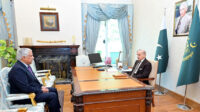The headline of every news channel these days revolve around the economic crisis that Pakistan is facing. The rupee has lost 15% of its value against the dollar, the current account deficit crossed $5bn, and has reached 4.7% of the GDP.
Moreover, foreign exchange reserves keep touching new lows and have now gone down to $16.25bn, after failed talks between the government and international donor agencies. As a result, inflation has skyrocketed in the past few months and the population living below the poverty line has only increased; making it difficult for many Pakistanis to barely survive.
For more such Opinions click here.
LESCO to start net metering connections from next month: CEO
Key for peace in world lies in strong, stable Afghanistan: Governor Punjab
In the last three months, those at the echelons of power are putting the blame of domestic inflation on the surge in international oil prices in the wake of the pandemic. However, there is little truth to it. This crisis, like so many of the past, is based on structural deficiencies present in the economic system of the country. The economic model of Pakistan is neither self-sustainable nor has the potential to improve without massive structural reforms.
In terms of the structural deficiencies in the teetering economic system of Pakistan, the most dominant is the low quality of export that Pakistan sells to the world. Most of the exports from Pakistan are non-value-added which includes agricultural items and raw materials. As a result, to meet the needs of its burgeoning population, Pakistan’s import bill is massive. For instance, Pakistan’s mobile phone export stands at 18 million, whereas its import is 45 million. This difference burdens the economy by ballooning the current account deficit.
Defeat of Pakistani team in Junior Hockey World Cup lamented
Cooperation with younger generation instrumental for positive image of police: IG
Chief of the Air Staff expresses grief over Indian CDS Gen Bipin Rawat’s tragic death
Apart from noncompetitive exports, the ease of doing business in Pakistan also impedes economic growth. Pakistan’s placement in the FATF gray list and its lackadaisical ease of business model prevent the flow of foreign direct investment into the country. Bureaucratic hurdles, a weak justice system, and the absence of corporate ease laws have pushed Pakistan to 108th place on the Ease of Doing Business Index 2021.
Besides this, the tax regime in Pakistan is also corrupt and inefficient. Around 1% of the population pays its taxes in the form of income tax. As a result, to meet its financial obligations, the government has to impose indirect taxes, which further elevate poverty and increase socioeconomic inequality in society. The tax net in Pakistan is narrow and restricted, it must be widened and made broad-based to improve the financial capacity of the government.
Canada joins US, Australia in boycott of Beijing Olympics
Pakistan will not attend US summit on democracy: Foreign Office
Antony Blinken to embark on Southeast Asia tour next week
Volatile current account and fiscal deficits have also increased unpredictability in the economic system of Pakistan. This is due to unsustainable exports of the country and inconsistent import bills. An increase in the price of oil in the international market, already the most expensive import of Pakistan, directly raises the import bill. Moreover, due to stressed foreign exchange reserves and lack of control over rupee value in the international market, investor confidence gets shaken. As a result, loans and international funds are needed to achieve some stability.
Pakistan’s reliance on external bail-out packages through financial aid has been perennial. Every time the country is under an economic crisis, its leadership seeks the solution in the IMF camp. As a result, Pakistan has knocked 22 times at the door of the IMF. And yet again, it is seeking to revive the $6bn loan facility which was halted last year over Pakistan’s noncompliance with various structural changes and austerity measures required by the donor.
For more such Opinions click here.
$3 Trillion market capitalization milestone in sight for Apple
US appeals court halts antitrust orders against Apple App Store
In conclusion, Pakistan’s economic woes cannot be solved without massive reforms. Structural reforms are needed at the macro level to make the economy self-sufficient and sustainable. Improving export quality, seeking new markets for exports, widening the tax net, and imposing direct taxes are the few initial steps to take. This will improve government spending capacity on infrastructure initiatives, socioeconomic programs, and welfare projects.
Horoscope predictions for today December 9, 2021
Stay tuned to Baaghi TV for more. Download our app for the latest news, updates & interesting content!






